Posts Tagged ‘TXI’
Another Chapter of “Why Don’t We See This in Midlothian?”
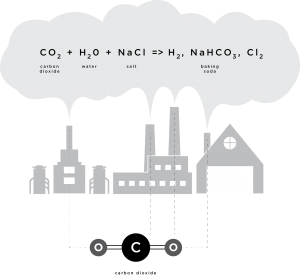 Cement plants are among the world's largest sources of CO2. In order to reduce their carbon footprints, either voluntarily or to comply with new environmental regulations, as well as make a buck, owners are trying out different strategies to turn their Greenhouse Gases into just plain green cash.
Cement plants are among the world's largest sources of CO2. In order to reduce their carbon footprints, either voluntarily or to comply with new environmental regulations, as well as make a buck, owners are trying out different strategies to turn their Greenhouse Gases into just plain green cash.
As far as we can tell, the "SkyMine" pilot-project announced for San Antonio's Capital Aggregates Cement Plant is still on schedule for operation later this year. Employing 50 people, the first-of-its-kind facility will convert the cement plant's carbon dioxide into baking soda and hydrochloric acid that's aimed at oil and gas field use.
Now comes word that a LaFarge Cement Plant in Canada is hooking up with a fuel cell company to make a slightly more progressive product from its GHGs:
"Mantra Energy Alternatives has struck a deal with Lafarge Canada to deploy an electrochemical reduction technology at Lafarge’s No. 9 Road cement plant.
“This will be the first pilot plant of its kind in the world,” said Mantra’s vice-president Patrick Dodd in a press release.
On paper, the technology would convert carbon dioxide, considered the most prolific greenhouse gas, into useful chemicals like formic acid and formate salts. The pilot plant would convert 100 kilograms per day of carbon dioxide emitted from the local cement plant into concentrated formate salts, which sell for about $1,500 per tonne.
Mantra is eying the formic acid for use in its patented fuel cells, which it bills as a significantly less expensive fuel cell with greater power density."
Granted, the manufacturing of oil and gas chemicals sounds more likely for one of the three huge Midlothian cement plants to attempt than diving into the alternative energy business, but at least it's something. The end products can change and adapt but these projects begin to put the infrastructure of a supply and demand system in place while seeing potentially large decreases in CO2 output. In 2014 America, the fastest way to get reductions in GHGs is to make it profitable to do so. These experiments pave the way for that to happen.
There's no question that the TX/ Martin-Marietta, Holcim and Ash Grove cement plants are the largest stationary sources of CO2 in North Texas, or that together, they form a huge GHG hotspot. All the old coal-fired power plants that would have challenged them have been shuddered or converted to gas.
While (forced) modernization at all three plants like the conversion from wet to dry kiln technology has brought all emission totals down, particularly CO2, the fact remains that the huge scale of operations in Midlothian means there's no other facilities that churn it out as much. And yet not one creative idea for how to reduce those huge local emissions has been announced from any of those companies. You can't just use the Texas excuse because the San Antonio experiment is happening despite no immediate government mandate, especially on existing facilities. And you might think that the first company to do so would receive some needed good PR. But nope.
This has been another chapter of "Why Don't We See This in Midlothian?"
End of an Era: TXI Cement Sold To Martin-Marietta
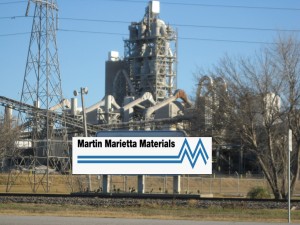 In a $2 billion deal, Raleigh, North Carolina-based aggregate and crushed stone manufacturer Martin Marietta Materials (a separate spin-off on the more well-know aerospace conglomerate) bought Dallas' own TXI Cement, which opened its first cement kiln in Midlothian in 1960.
In a $2 billion deal, Raleigh, North Carolina-based aggregate and crushed stone manufacturer Martin Marietta Materials (a separate spin-off on the more well-know aerospace conglomerate) bought Dallas' own TXI Cement, which opened its first cement kiln in Midlothian in 1960.
This year, that kiln, along with the three other obsolete wet kilns at TXI's Midltohian plant that burned hazardous waste for two decades, is due to be demolished, following the company's corporate demise at the hands of the grandson of its founder. And then, the last remnants of the old TXI will be gone for good.
What does the change in ownership mean for breathers in North Texas?
Martin Marietta has owned and operated cement plants around the US in the past, but they'd divested themselves of these prior to 2014. As of now, the TXI cement plants in Texas and California are apparently the only ones the company owns. There's some speculation that Martin-Marietta bought TXI for its aggregate, stone, and concrete facilities in Texas and California, and will soon seek a buyer for the cement plants it inherited, but doesn't really want.
If that's true, the new owners will act as placeholders of the status quo, not investing in big new capital projects, but also trying not to lose any of the value of the assets they now have by running them into the ground. Martin probably won't look favorably upon attempts to bring smog-reducing modern Selective Catalytic Reduction (SCR) technology to TXI via the next clean air plant for DFW, now due in June of 2015. Not only would the plant be among the first to adopt the technology in the US, (even though SCR has been successfully used in European cement kilns for over a decade now), but it would mean new capital investment and a new learning curve.
Swiss-based Holcim Cement, with a huge plant already in Midlothian and a large manufacturing footprint in the US, was rumored to be one of TXI's suitors before the sale was announced. It could be that Holcim, or another well-established player in the cement industry winds up with the actual kilns in the next year. That could complicate the plant's participation in the new clean air in other ways even if new owners are not as intimidated by the demand for new technology
Politically, it'll be interesting to see which Austin lawyers and lobbyists get the business of the new company. Martin-Marietta owns over 40 facilities in Texas already and is represented by it's own crew. Will TXI's law firm and lobbyists survive the buy-out? There are industry lobbyists that will keep the ball rolling no matter what – the Chemical Council, the Aggregate Association, etc. But in Austin, it's all about relationships, and it's hard to say yet how this Martin's buying of TXI changes any of them.
Maybe the place TXI's absence will be felt the most in in the corridors of power in DFW. TXI was proudly headquartered in Dallas. Ralph Rogers, TXI's founder and patriarch was a driving force in local philanthropy, giving millions to public broadcasting (KERA is housed is housed in the "Ralph Rogers Communications Center") and other non-profits. Besides feeing like he was entitled to use PBS's iconic Big Bird to sell the benefits of burning hazardous waste in 50-year-old cement kilns, the non-profit giving Rogers was responsible for made him a known figure on the Dallas Charitable circuit. In turn, this made it hard for the Powers That Be to criticize Roger's company when it became a waste incinerator.
Locally, the establishment played golf with the Rogers' or attended black tie dinners with them, or helped them lift the oversized scissors at ribbon-cutting ceremonies. But that was old Dallas. Hardly of those relationships survived past Ralph Rogers' death in 1997. His son, Robert, failed to maintain that same high-profile locally, and his grandson Jamie seems totally disinterested in the family business or its legacy of charitable giving.
Now, the move of company headquarters from Dallas to Raleigh will complete the disappearance of the once-mighty TXI on the local scene. They'll still be company representatives at functions, but it won't be the guy who can write the big checks, or who the Mayor had a splendid time with last Saturday at the Club.
The company's local political influence has forever been diminished, and that's a good thing for citizens who are fighting the company to get modern controls like SCR. Now, it's just one more corporate entity with a presence in North Texas. A presence that makes it the single largest air polluter in the region. That's the way Dallas and other downwind cities should have viewed the company all along.
TXI Stock Takes a Dive, New North Texas Cement Plant on Way?
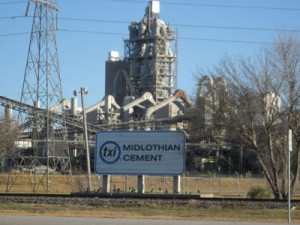 Last Wednesday TXI stock didn't do as well as Wall Street thought it should for the quarter and the result was about a 10% drop in value over one day's trading. On a Thursday conference call, CEO Mel Brekhus defended the company's prospects, including the opening of its new Central Texas plant, saying it "was the most successful of any he had been involved with in his career." We imagine that's right since the only other plant the company has built recently was Kiln #5 in Midlothian which faced opposition from Downwinders and others in the early part of the last decade.
Last Wednesday TXI stock didn't do as well as Wall Street thought it should for the quarter and the result was about a 10% drop in value over one day's trading. On a Thursday conference call, CEO Mel Brekhus defended the company's prospects, including the opening of its new Central Texas plant, saying it "was the most successful of any he had been involved with in his career." We imagine that's right since the only other plant the company has built recently was Kiln #5 in Midlothian which faced opposition from Downwinders and others in the early part of the last decade.
But most intriguing from DFW residents' point of view was the hint that Brekhus casually dropped toward the end of the call that the company was thinking about "increasing capacity" in North Texas. You know what that's code for – a new cement kiln.
Midlothian has been home to the nation's largest concentration of cement manufacturing for a long time, but such an addition would solidify its position for decades to come. That's because these days kilns come in one size – very, very large. A new TXI kiln would be massive in all respects. Air pollution would go up considerably, possibly canceling out some gains that have been made by the shutting down of the seven older wet Midlothian kilns that were ground zero for waste-burning from 1986 to 2008. Particulate Matter, smog-forming pollution and more exotic poisons like Dioxins would increase substantially.
Moreover, TXI might be looking for new ways to make money besides making cement – just like they did when they turned their kilns into hazardous waste incinerators for profit. Around the world the cement industry is focusing a lot of effort into becoming waste incinerators for municipal solid wastes, medical wastes and "unrecyclable plastics." Just like they did when they were burning hazardous waste, they charge customers for the right to burn their garbage. TXI recently expanded their list of fuels to include car parts and plastics. Might a new kiln increase the need to develop even larger markets for waste to burn?
It could be PR talk for the investors or reflect real corporate thinking at TXI headquarters. As part of their planning, executives would be advised to also think about the opposition to such a plant now. Midlothian is a different place than it was even 13 years ago, much less 25. People who've moved there recently might not want to see a new source of air pollution, especially one devoted to being a garbage burner. It's not quite the company town it was. And instead of facing a fledgling group, they'd be up against an organization that knows how to win the war. Stay tuned.
Downwinders and Others File Stay Against EPA Over Weakened Cement Plant Rules
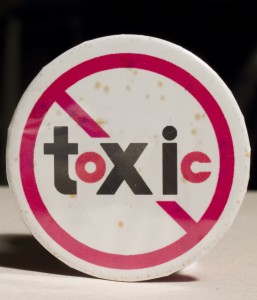 Seventeen years and counting – that's how long Downwinders at Risk has been fighting to get the EPA to modernize their rules for waste-burning cement plants. And we're not giving up.
Seventeen years and counting – that's how long Downwinders at Risk has been fighting to get the EPA to modernize their rules for waste-burning cement plants. And we're not giving up.
On Wednesday, a national coalition of environmental and community groups that included Downwinders at Risk asked a federal court to stay a decision by the U.S. Environmental Protection Agency to weaken and delay Clean Air Act protection against toxic pollution from cement plants.
By the agency’s own calculations, the delay will cause between 1,920 and 5,000 avoidable deaths and will allow cement plants to release an additional 32,000 pounds of mercury into the environment.
The complete list of groups seeking relief include Cape Fear River Watch, Citizens’ Environmental Coalition, Desert Citizens Against Pollution, Downwinders at Risk, Friends of Hudson, Huron Environmental Activist League, Montanans Against Toxic Burning, PenderWatch & Conservancy, and the Sierra Club, all of which have members who live and work in close proximity to cement plants and have suffered from cement plants’ excessive pollution for many years. Earthjustice filed the stay motion on their behalf in the U.S. Court of Appeals for the D.C. Circuit. A copy of the groups’ motion can be found here: Cement Motion to Stay Rule
Cement plants are among the nation’s worst polluters, emitting vast quantities of particulate matter, mercury, lead, and other hazardous air pollutants.
“As if gutting and delaying the rule were not bad enough, EPA has essentially created a compliance shield for the industry, making it impossible for citizens to hold facilities accountable for their toxic emissions. These changes in the cement rule are irresponsible and reckless,” said Jennifer Swearingen, of Montanans Against Toxic Burning.
“Los Angeles is ringed by cement plants, and three of them operate near my home in Rosamond,” said Jane Williams, of Sierra Club and Desert Citizens Against Pollution. “The pollution from these plants hurts the people in this community and robs us of the outdoor lifestyle we came here to enjoy. We can’t wait two more years to get relief from these plants’ pollution. I don’t want anyone in these communities to be among the people this pollution is going to sicken and kill.”
Our own Midlothian is the cement capital of the United States and so Downwinders at Risk' Director Jim Schermbeck had something to say about the move. “The EPA seems to have learned nothing from having cement plants exploited as inadequate hazardous waste incinerators. As cement plants are once again becoming the nation’s Dispos-All, and new wastes are generating new emissions, the Agency is weakening air pollution controls and making it easier for cement kilns to poison their neighbors. It was wrong to turn kiln into incinerators in the 1980s and it’s wrong to try and do so again in the 21st century – especially accompanied by a roll back in regulations."
In North Carolina groups are fighting a massive proposed cement plant. “A gigantic foreign cement company wants to build one of the world’s biggest plants here,” said Allie Sheffield, of PenderWatch and Conservancy, a group that works to protect the coastal ecosystem in Pender County, North Carolina. “If this plant is built, EPA’s new rule will let it emit twice as much lead, arsenic, and particulate matter into our air and waters. At this point, I have to ask – why do they call it the Environmental Protection Agency?”
William Freese, of Huron Environmental Activist League, lives near what the EPA’s Toxic Release Inventory lists as the dirtiest cement plant in North America for point source pollution. “This makes one wonder how the EPA, in violation of U.S. Court of Appeals’ order, can allow this company to do keep polluting for two more years. By the time they get around to finally doing what’s right, they won’t have any environment to protect,” Freese said.
“Federal law required EPA to put limits on this pollution more than a decade ago,” Earthjustice attorney James Pew said. “But under one administration after another, the agency has refused to put limits in place. Real people suffer as a result of EPA’s scofflaw behavior, and now they are going to court to say ‘enough is enough.’”
The 1990 amendments to the Clean Air Act required EPA to limit cement plant’s emissions of hazardous air pollutants such as mercury. In 2000, a federal court had to order EPA to set these standards after the agency refused to do so.
In 2010, in response to a lawsuit filed by Earthjustice on behalf of community groups living in the shadow of cement plants, EPA finally set the standards that the Clean Air Act had required it to set more than a decade before. These standards would have significantly reduced cement plants’ emissions of soot, mercury, lead, benzene and other toxic pollutants by September of this year.
Rather than acting to clean up their pollution, cement companies attacked EPA’s new rule in court and in Congress. The attacks failed. The court denied their request to vacate or delay the standards, and legislative efforts to do the same failed to gain support on the Hill.
In 2013, however, the EPA voluntarily gave the cement industry the very relief it had failed to get in court or in Congress. It delayed emission reductions that were already more than a decade overdue for another two years, until 2015. Additionally, EPA weakened particulate matter standards and eliminated requirements that would have required cement plants to monitor and report their emissions to the public.
Citizens are down but not out. And we will never rest until we see cement plants regulated the way they should be when they burn so many different types of waste. We can fight this fight because of your support over the years. Please help us keep fighting by putting a bill in the tip jar. We need your help to raise our 2013 budget to keep our staff in the field working for your lungs. Thanks.
Your’re Downwind of Lots of Burning Trucks
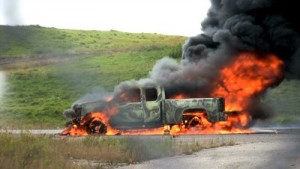 A funny thing happened to Dallas Morning News automobile columnist Terry Box while he was out test driving a new Dodge pick-up truck – it self-immolated and burned to ashes on the side of the road. As he writes about it, his experience is both funny and terrifying. But something he noted in how cars and trucks are made these days caught our eye:
A funny thing happened to Dallas Morning News automobile columnist Terry Box while he was out test driving a new Dodge pick-up truck – it self-immolated and burned to ashes on the side of the road. As he writes about it, his experience is both funny and terrifying. But something he noted in how cars and trucks are made these days caught our eye:
"Open the hood of your late-model car or truck, and you’ll see a half-acre of plastic — actual engine pieces like valve covers, caps and containers for various liquids.
Thirty years ago, most of the pieces under the hood were metal and resistant to fire.
A fire in a modern vehicle burns fast and furiously. What’s intact for the moment can be gone or enveloped in toxic smoke in a matter of seconds."
Yep. When we've described the lovely new cement additive called ASR – Auto Shredder Residue – we've often talked about all the vinyl seats, dashboard and switches that get stipped out of a car and shredded, then thrown into a cement kiln. We really haven't talked about all the plastic in the engine compartment that would also be included in this new "fuel" that TXI has already been permitted to burn at its Midlothian cement plant.
As more and more of every car is made of "soft materials" – that is, not metal – more and more of it becomes fodder for cement kilns. This is material that could be recycled but isn't, and as long as it's cheaper just to burn it, there won't be amrket for recycling it.
Here's the thing, burning plastic creates bad kinds of pollution, including the creation of Dioxin, one of the most potent posions ever discovered by science. The same "toxic smoke" Terry Box saw pouring off of his burning Ram pick-up is created when you throw the same plastic parts into a cement kiln. The cement industry would like you to think that all of that is taken care of by the polluton control measures installed at the kilns, but it's not. There's no real time Dioxin montoring, much less any kind of monitoring for the host of other exotic fumes coming off burning plastic of various kinds. They barely even know what or how to test for such pollutants, but that doesn't keep the cement industry from marketing its kilns as "Long, Hot, and Good for America"™
If you're an old-timer, you might remember an earlier episode or two that occurred when the cement industry, including TXI, assured everyone that it could burn hazardous waste and make it completely disappear into water vapor. Remind us, how did that turn out?
Scientists: Classify Plastic As Hazardous Waste
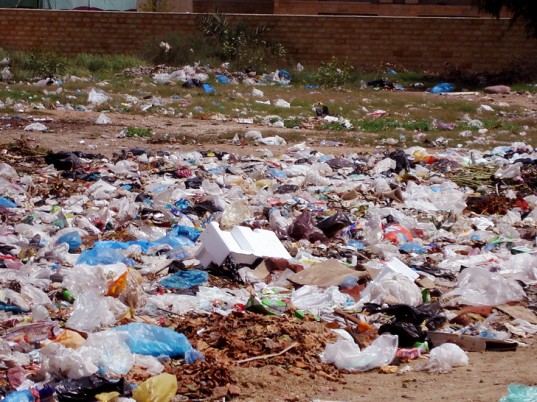 We missed this the first time around, so we're glad that "Living on Earth" caught it again. A group of scientists, including marine biologist Chelsea Rochman, recently signed an article in the magazine Nature that called for classifying plastic as a hazardous waste.
We missed this the first time around, so we're glad that "Living on Earth" caught it again. A group of scientists, including marine biologist Chelsea Rochman, recently signed an article in the magazine Nature that called for classifying plastic as a hazardous waste.
What's the rationale? It turns out to be pretty solid and based on current regulations. As Rochman described it,
Waste is basically separated into two categories, those that are non-hazardous like grass clippings, and those that are considered a hazard, which are often based upon this long list of priority pollutants, or substances that the government deems are hazardous to organisms. And we found that plastics are associated with 78 percent of these priority pollutants listed by the US EPA and 61 percent listed by the European Union, either as a chemical ingredient of the plastic itself or when the plastic ends up in the aquatic environment; they absorb these contaminants from the water. And so from that perspective we thought maybe plastic as a waste product should also be considered as a hazardous substance.
Rochman cites styrene in Styrofoam as an example of a well-known pollutant that's incorproated into plastic. Another is vinyl chloride that's used to make PVC.
Plastics' threat to marine life has been well-documented, but it's also a threat to those living downwind of places that burn plastic wastes – like an increasing number of cement plants, including TXI's huge Midlothian Kiln #5. Besides being assaulted by the leftovers of the ingredients in the original plastic, downwind neighbors are also subjected to entirely new pollutants that are made ONLY when plastics are burned. The most notorious of these is Dioxin, one of the most potent poisons ever tested. Dioxin is what made Agent Orange so toxic to Vietnamese and veterans alike. It's why Times Beach Missouri is a Superfund Site. And it's what's released every time plastics are burned.
Incineration of plastics is dramatically increasing despite producing this kind of pollution. Classifying this waste as "hazardous" might be the only way to limit their use as "fuel" in cement kilns that weren't built to be garbage incinerators.
Hell Freezes Over: Why the New Federal Report on Midlothian Matters
Everything in italics and "quotation marks" below is a direct quote from the latest chapter of the ATSDR's (Agency for Disease Registry and Toxic Substances) "health consultation" on the impact of certain kinds of industrial air pollution on the local population.
You should take five minutes to glance over the sentences. They've taken a better part of a decade and a great deal of citizen persistence to make it to print. You can read them now only because of a petition to ATSDR by local Midlothian residents, spearheaded by Sal and Grace Mier in 2005, prompted the Agency to get involved.
They're also rarer than hen's teeth. Because the words actually come together in sentences to conclude human health was likely harmed by the pollution from Midlothian's three cement plants and steel mill, as well as recommend decreasing that pollution.
Among grassroots activists, ATSDR has a notorious reputation for issuing reports that are "inconclusive by design." The joke is that the agency never met a facility it couldn't learn to live with. And sure enough, previous chapters in this saga have disappointed. Just two years ago, ASTDR's shoddy work in investigating health impacts in Midlothian and elsewhere across the country was the subject of a Congressional hearing.
These ATSDR reports generate no new data. Instead, they are retrospective looks back at the available sampling/monitoring information and a piecing together of possible exposure paths and levels. As such, they're only as good as the data they can digest. In Midlothian's case, that means they're completely dependent on state monitoring – criticized by citizens for years as being inadequate. Nevertheless, with this latest report, citizens have been somewhat vindicated because of what even that inferior sampling revealed.
The health impacts described in this latest report are also limited to what are called "Criteria Pollutants" – old school substances like lead, soot, sulfur dioxide, and ozone that have been regulated by the Clean Air Act for decades. They do not apply to more exotic kinds of air pollution like endocrine disruptors, which there's little or no monitoring for at all.
So there are a lot of missing pieces, but the ATSDR's conclusions and recommendations have an impact on your lungs and maybe your own local fight, even if you don't have a Midlothian zip code. For the first time a federal agency known to avoid coming to any conclusion about anything was forced to say that human health was adversely affected by the operations of industry in Midlothian.
There's a public meeting on this report on December 6th from 7 to 8:30 pm at the Midlothian Conference Center.
Health Consultation/Assessing the Public Health Implications of the Criteria (NAAQS) Air Pollutants and Hydrogen Sulfide MIDLOTHIAN AREA AIR QUALITY MIDLOTHIAN, ELLIS COUNTY, TEXAS
NOVEMBER 16, 2012 U.S. DEPARTMENT OF HEALTH AND HUMAN SERVICES
Agency for Toxic Substances and Disease Registry
Division of Community Health Investigations
Recommendations:
"Texas Commission on Environmental Quality (TCEQ) should take actions to reduce future SO2 emissions from TXI to prevent harmful exposures."
"TCEQ should take actions to reduce future PM2.5 emissions from TXI and Gerdau to prevent harmful exposures."
"TCEQ should continue efforts to reduce regional ozone exposures."
"TCEQ should insure that levels of these air pollutants do not increase to levels of concern in the future."
"TCEQ should conduct ambient air monitoring to characterize exposures to persons located downwind of the Ash Grove and Holcim facilities and take actions to reduce SO2 emissions from these facilities if harmful exposures are indicated."
"TCEQ should conduct appropriate ambient air monitoring to characterize exposures to persons located downwind of the Ash Grove and Holcim facilities and take actions to reduce PM2.5 emissions from these facilities if harmful exposures are indicated. In addition, particulate matter monitoring is needed in residential areas that are in immediate proximity to the facilities’ limestone quarries."
"In ATSDR’s judgment, one notable gap in monitor placement is the lack of monitoring data for residential neighborhoods in immediate proximity to the four industrial facilities, where fugitive emissions (those not accounted for in stack emissions) likely have the greatest air quality impacts."
Human health was likely harmed, and is still threatened by industrial pollution from Midlothian
From Sulfur Dioxide:
"Breathing air contaminated with sulfur dioxide (downwind of TXI's cement plant and the Ameristeel steel mill) for short periods could have harmed the health of sensitive individuals.…ATSDR cannot determine if harmful exposures to SO2 have been occurring downwind of the Holcim and Ash Grove facilities."
"All 24-hour values in Midlothian were lower than EPA’s former standard. However, the World Health Organization’s health comparable guideline is 8 ppb (WHO, 2006). This value was exceeded at both the Midlothian Tower and Old Fort Worth Road stations in most years of monitoring through 2008…"
"Overall, in the years 1999 to 2001, Old Fort Worth Road (monitoring site north of TXI) ranked among the stations with the highest 24-hour average sulfur dioxide concentrations in the state. As sulfur dioxide emissions from TXI Operations decreased in following years, so did the measured concentrations at this station."
From Particulate Matter, or Soot:
"Public health concern is warranted for adverse health effects from long-term exposure to PM 2.5 in Cement Valley"
"In the past (1996–2008), annual average PM 2.5 levels measured were just below the range of concentration proposed by EPA for lowering the annual average standard…Moreover, many of the annual average PM 2.5 concentrations were above the more conservative WHO health guideline (10 μg/m3)."
"No PM 2.5 monitoring data are available to evaluate exposures downwind of the Ash Grove facility. Furthermore, although annual average PM2.5 levels detected at the Holcim monitor indicate possible harmful levels…."
"We estimated that annual average PM2.5 levels in the vicinity of the Gerdau Ameristeel monitor, from 1996 to 1998, could have ranged from about 22.6 to 26.4 μg/m3, which is above both the current and proposed EPA standard. Using EPA’s approach, the 3-year average level might have been above the NAAQS standard of 15 μg/m3 for these years in the vicinity of the Gerdau Ameristeel monitor. Applying this same approach to annual average PM10 data from other monitors suggests that PM 2.5 levels could have been close to the current and proposed PM2.5 standard, especially for the Wyatt Road, Old Fort Worth Road, Gorman Road, and Midlothian Tower monitors."
"Consistent with the other pollutants discussed earlier, the estimated annual PM 2.5 emissions listed for these facilities are among the highest for Ellis County and also rank high among industrial sources statewide."
From Lead:
"Past lead air exposures during the period 1993 to 1998, in a localized area just north of the Gerdau Ameristeel fence line, could have harmed the health of children who resided or frequently played in this area….In the mid-1990s, the lead levels measured in this area ranked among the highest lead concentrations measured statewide."
From Smog:
"Scientific studies indicate that breathing air containing ozone at concentrations similar to those detected in Midlothian can reduce lung function and increase respiratory symptoms, thereby aggravating asthma or other respiratory conditions. Ozone exposure also has been associated with increased susceptibility to respiratory infections, medication use by persons with asthma, doctor’s visits, and emergency department and hospital admissions for individuals with respiratory disease. Ozone exposure also might contribute to premature death, especially in people with heart and lung disease. School absenteeism and cardiac-related effects may occur, and persons with asthma might experience greater and more serious responses to ozone that last longer than responses among people without asthma."
"The Midlothian Tower site recorded ozone concentrations above the level of the NAAQS for several years (TCEQ, 2011b), and the Old Fort Worth Road site has been measuring ozone concentrations close to the level of the NAAQS. Based on the data from both monitors, from August 1997 to September 2011, the 8-hour EPA ozone standard has been exceeded 236 times."
From Breathing Multiple Pollutants:
"ATSDR believes that sufficient information exists to warrant concern for multiple air pollutant exposures to sensitive individuals, especially in the past….The ability of the scientific community to fully and quantitatively evaluate the health effects from the mixture of air pollutants people are exposed to is at least ten years away (Mauderly et al., 2010)……The current state of the science limits our ability to make definitive conclusions on the significance of simultaneous exposures to multiple criteria air pollutants. ATSDR’s conclusions are based on our best professional judgment related to our understanding of the possible harmful effects of air pollutant exposures in Midlothian and our interpretation of the current scientific literature; therefore, these conclusions are presented with some uncertainty."
From New Production:
"Reductions in SO2 levels in Cement Valley have occurred since late 2008 resulting in exposures to both sensitive individuals and the general public that are not expected to be harmful. These reductions may be caused, in part, by declining production levels at local industrial facilities. Future harmful exposures in Cement Valley could occur if production rises to at least previous levels and actions are not taken to reduce SO2 emissions."
Regulatory "Safe Levels" Very Often Aren't
"Past SO2 exposures were not above the Environmental Protection Agency (EPA) standard in place at that time but were above the current standard."
"Past lead air exposures were not above the EPA standard at that time but were above the current standard.…The scientific community now believes that the current standard (15 μg/m3) for fine PM (measured by PM2.5) is a better indicator of possible long-term health effects from PM exposures than was the former EPA annual average standard for PM10 (EPA, 2006b)."
Midlothian Cement Plants Linked to Higher Child Asthma Rates
On the left is a computer-modeling image from the Texas Commission on Environmental Quality showing the direction of the predominant downwind plume of pollution from the three Midlothian cement plants - from extreme NW Ellis County, blowing diagnoally across Tarrant County and into Wise County. On the right is the map from the original 2009 Cook Children's Hospital CCHAPS study indicating levels of childhood asthma in the Hospital's service area. It tracks closely with the direction of the plume and asthma levels increase in closer proximity to the cemnt plants. 
According to researchers Patricia Newcomb and Alaina Cyr from the UTA College of Nursing "…the bulk of Tarrant County asthma cases lie directly in the path of southeasterly winds that have historically carried high levels of particulate matter from working cement kilns in a neighboring county. Asthma prevalence increases in a linear configuration within the path of the 'cement plume' as residential location comes closer to the cement kiln area."
Exposure to Particulate Matter pollution, or soot, is a well-known known cause for asthma. It can also make a child's asthma worse.
"This latest study is one more piece of empirical evidence that we need to decrease pollution from the Midlothian cement plants to secure the right of our children to breathe without getting sick, " said Jim Schermbeck, Director of Downwinders at Risk, a local group originally founded in 1994 to oppose the burning of hazardous waste in the Midlothian cement plants.
Proximity to the pollution from the three Midlothian cement plants was the only environmental factor geographically associated with higher concentrations of childhood asthma, ruling out poverty and indoor air pollution. There also wasn't a strong correlation to urban gas drilling, although the authors concede that "urban drilling may play a part as well" in the region's higher than normal child asthma rates, and there was no direct comparison between the geography of drilling activity and area asthma levels.
In 2009, Cook Children's Hospital released its Community-wide Children's Health Assessment and Planning Survey (CCHAPS), the largest examination of childhood health in North Texas ever undertaken. It found that Tarrant County and the western side of the North Texas region suffer childhood asthma rates significantly higher than state and national averages.
In "Conditions Associated with Childhood Asthma in North Texas," published in the October edition of ISRN Allergy, Newcomb and Cyr revisit the Cook study and delve more deeply into its data. "The purpose of this study was to identify significant associations between asthma diagnosis, comorbid conditions, and social problems in children." The complete article can be accessed on the Cook Hospital CCHAPS website page devoted to asthma, under "Special Reports."
Midlothian is the home of the largest concentration of cement plant manufacturing capacity in the United States. It hosts three large cement plants – TXI , Holcim and Ash Grove – with a total of six kilns. They are the largest stationary sources of pollution in North Texas. Reports submitted by the plants themselves show they poured over a million pounds of Particulate Matter pollution into the North Texas air in 2009.
EPA recently announced that it was considering once again delaying the implementation of new federal emission rules, including stricter particulate matter pollution standards, from 2013 to 2015 that have been in the works for two decades. The delay would also water down proposed PM pollution standards. Schermbeck said Newcomb and Cyr's analysis shows the real world costs of such a rollback.
"It's a scientific fact, endorsed by EPA, that inhaling tiny bits of particulate matter can make people sick and even kill them. What this study makes clear is that the agency is senselessly condemning more Tarrant County kids to illness and suffering by delaying rules that were supposed to have been in place in the 1990's. It's time to start saving lives by reducing this kind of pollution."
Another Waste Fire at a Waste Burning Cement Plant
Indian downwinders complain of air pollution from their local cement kiln
This time in India instead of Utah or South Carolina.
In Coimbatore, plastic and leather wastes stockpiled waiting to be burned as "fuel" at the Madukkarai cement works spontaneously combusted in a three hour fire that did not result in any known injuries at the plant.
However, thick columns of black smoke poured into the sky and that stuff, as the late Dr. Commoner would note, has to go somewhere. A lot of it will no doubt dind its way into the lungs of downwind residents. More than 200 tons of waste was gutted in the fire out of at total twice as large.
Despite local fire officials urging the cement plant to enclose the waste for some time, it had not done so. That is an apparent violation of state law. And readers, will it surprise you in the least to learn that the plant was already a longtime source of complaints from local residents?
Meanwhile the Fire and Rescue Services Department officials pointed out that storing combustible waste materials outside the plant without adequate protection was in violation of the Tamil Nadu fire service rule of 1990.
"It is a violation of section 250 of Tamil Nadu Fire Service Rules 1990 and we will issue a notice to the factory and will give them 15 days to store the waste materials inside a roofed structure with protective walls," said Subramanian.
Residents have been protesting against the cement factory for a long time and have submitted numerous petitions to the district administration. They claimed that the dust and smoke from the factory was causing major health complications, especially for senior citizens and children.
"We have raised the issue on numerous occasions and also submitted petitions to the district administration but till now no action has been taken," said C Palaniswamy, a resident of Kurumbapalayam.
There is a premeditated and orchestrated campaign by the cement industry to allow kilns to become garbage burners of all kinds of wastes. We've seen it manifest itself locally in Midlothian with the TXI permit that allows that plant to burn car parts and plastic wastes.
The more kilns that become gargabe burners, the more garbage of dubious content will pile up at kilns, the more often that garbage causes a fire. We've reported on three just since the summer alone. Being downind of an uncontrolled garbage fire isn't one of the talking points the industry boasts about when it's trying to sell kilns as the industrial equivalent of Kitchen disposals, but it's looking more like a standard feature rather than an option.
